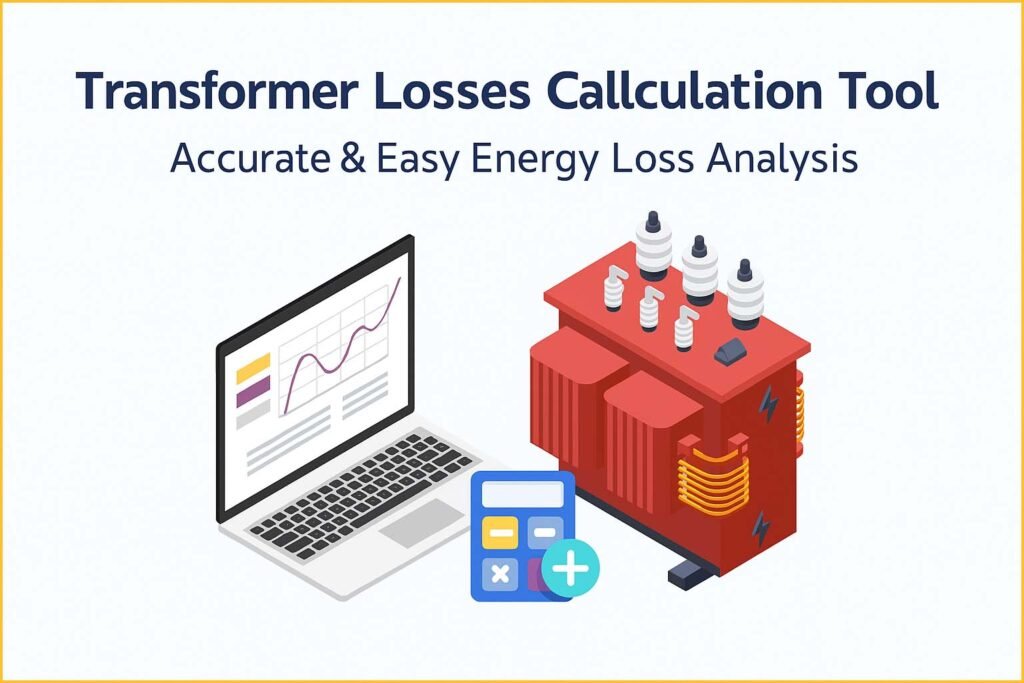Transformer Losses Calculation Tool – Accurate & Easy Energy Loss Analysis
A Transformer Losses Calculation Tool helps engineers estimate the total losses that occur inside a transformer during operation. These losses directly influence energy efficiency, long-term reliability, and operating costs. With rising electricity prices and increasing demand for efficient electrical systems, such a tool has become critical for industries, utilities, and engineering service providers.
Many engineers calculate losses manually. This takes time and increases the chance of error. A dedicated tool makes the job faster, more accurate, and easier to repeat. It also helps teams compare transformer designs, evaluate loading patterns, and plan for future capacity upgrades.

Table of Contents
Understanding how the tool works is essential for accurate power system analysis. This article explains transformer losses, calculation methods, and the benefits of using a reliable Transformer Losses Calculation Tool.
Understanding Transformer Losses
A transformer has two main types of losses. These include no-load losses and load losses. Each affects efficiency differently. Knowing their behavior helps you interpret the results generated by a calculation tool.
No-Load Losses
No-load losses occur when the transformer is energized but not supplying load. They stay almost constant throughout the transformer’s operation.
These losses mainly include:
Transformer Losses Calculation Tool
Estimate daily and annual energy losses in a transformer based on load factor, core and copper losses, and operating hours. Includes cost impact in USD and efficiency insights.
How to Use: Enter transformer rating, load factor, core and copper losses, and operating schedule. The calculator estimates energy loss and cost impact based on real-world usage.
- Core losses
- Hysteresis losses
- Eddy current losses
No-load losses depend on voltage and frequency. They do not depend on load current. This makes it essential to calculate them precisely, especially for transformers that operate around the clock.
Know more about IEC Standards for Transformer Testing – Complete Guide to IEC 60076 and Testing Procedures
Load Losses
Load losses occur when the transformer carries current.
These losses rise with load and include:
- Copper losses
- I²R losses in windings
- Stray losses
- Additional losses due to harmonics
Load losses increase with the square of the current. This means even a small increase in load can cause a significant rise in loss. A Transformer Losses Calculation Tool helps engineers visualize this effect quickly.
Why a Transformer Losses Calculation Tool Is Important
A calculation tool helps engineers make faster and more accurate decisions.
Key benefits include:
- Reduced manual errors
- Faster technical evaluations
- Accurate loss calculations based on real parameters
- Better load management
- Improved design and purchasing decisions
- Enhanced energy optimization in large installations
Energy efficiency rules are getting stricter. Many utilities now require detailed loss evaluation before approving new transformers. A reliable tool makes compliance easier.
Key Inputs Required in a Transformer Losses Calculation Tool
The accuracy of the results depends on the data entered in the tool. Below are common input fields used in most professional tools.
Typical Input Parameters
| Parameter | Description |
|---|---|
| Rated Power (kVA/MVA) | Transformer’s nameplate rating |
| Primary Voltage | Input voltage level |
| Secondary Voltage | Output voltage level |
| Frequency | Typically 50 Hz or 60 Hz |
| No-load Loss (W) | Manufacturer-provided |
| Load Loss (W) at Rated Load | Manufacturer-provided |
| Impedance (%) | Affects short-circuit calculations |
| Load Profile | Percentage of rated load |
The tool uses these parameters to compute total losses during different loading conditions.
Know more about IEC Standard for XLPE Cables – Complete Guide to IEC 60502 and Electrical Cable Specifications
How Transformer Losses Are Calculated
A Transformer Losses Calculation Tool follows standard formulas used in electrical engineering.
Formula for Total No-Load Loss
Total No-Load Loss = Core Loss + Hysteresis Loss + Eddy Current Loss
Most tools use a single value called “no-load loss” provided by the manufacturer.
Formula for Load Loss at a Specific Load
Load Loss at Given Load = Rated Load Loss × (Load%)²
For example, if a transformer has 5000 W load loss at full load and operates at 70% load:
Load Loss = 5000 × (0.7)²
Load Loss = 5000 × 0.49
Load Loss = 2450 W
A tool calculates this instantly for multiple load levels.
Formula for Total Transformer Losses
Total Losses = No-Load Loss + Load Loss at Given Load
Efficiency Formula
Efficiency (%) = Output Power / (Output Power + Total Losses) × 100
Load for Maximum Efficiency
Load for Maximum Efficiency = √(No-Load Loss / Load Loss at Rated Load)
Technical teams use this value to plan the optimum operating range of the transformer.
Key Features to Look for in a Transformer Losses Calculation Tool
A good calculation tool is more than a simple formula calculator. It should support engineering workflows.
Essential Features
- Easy user interface
- Load profile selection
- Loss evaluation at multiple load points
- Efficiency curve generation
- Cost of losses calculator
- PDF or Excel export option
- Comparison between multiple transformers
Know more about IEC Standard for Vacuum Circuit Breaker – IEC 62271 Guidelines, Ratings & Testing Explained
A robust tool also supports harmonic analysis. Harmonics increase stray losses. Without this feature, the results may underestimate losses in modern industrial systems.
Example: Transformer Loss Calculation Using a Tool
To illustrate, consider the following transformer specifications:
| Specification | Value |
|---|---|
| Rating | 1000 kVA |
| No-load Loss | 1800 W |
| Load Loss at Full Load | 9000 W |
| Operating Load | 60% |
A calculation tool processes these values.
Step-by-Step Breakdown
Load Loss at 60% = 9000 × (0.6)²
Load Loss = 9000 × 0.36
Load Loss = 3240 W
Total Losses = 1800 + 3240 = 5040 W
If the tool also calculates annual energy cost, it may include operating hours and electricity tariff.
For example:
Annual Energy Loss = Total Losses × 24 × 365
Annual Energy Loss = 5040 × 8760
Annual Energy Loss = 44,150,400 Wh
Annual Energy Loss = 44,150 kWh
A tool automates these estimates, saving time and enhancing accuracy.
How These Tools Help in Procurement and Maintenance
Utilities and industrial plants often evaluate multiple transformers before procurement. Losses play a major role in lifetime cost evaluation. A Transformer Losses Calculation Tool helps engineers compare:
- High-efficiency vs. standard models
- Different brands
- Different load ratings
- Life-cycle cost of losses
Even a small difference in losses can translate into significant long-term savings.
Use our online tool Generator Power Consumption Calculator – Accurate Tool to Estimate Fuel and Load Usage
During maintenance planning, the tool helps evaluate:
- Load balancing
- Overloading risks
- Expected efficiency drop
- Impact of harmonics due to new equipment
This allows teams to design preventive strategies.
The Role of These Tools in Energy Efficiency Programs
Many regions follow MEPS (Minimum Energy Performance Standards). A transformer must meet specific loss limits to comply.
A calculation tool helps organizations:
- Verify transformer compliance
- Document results for audits
- Support energy management strategies
- Reduce operational costs
- Forecast long-term savings
Energy audit consultants rely heavily on these tools for report preparation and data verification.
Future Trends in Transformer Loss Calculation
As digital power systems evolve, transformer loss calculation tools are also improving.
Emerging trends include:
- Cloud-based tools
- AI-assisted load prediction
- Integration with SCADA systems
- Real-time loss monitoring
- IoT-based transformer diagnostics
Modern tools provide dashboards that show losses, temperature profiles, and load behavior. This helps facilities make data-driven decisions.
Use our online tool Sub Panel Breaker Size Calculator – Find the Right Breaker for Your Electrical Sub Panel
Conclusion
A Transformer Losses Calculation Tool is essential for accurate evaluation of transformer performance. It simplifies complex calculations, reduces errors, and helps engineers make informed decisions. With increasing demand for energy efficiency, such tools are becoming standard in industrial and utility applications. Whether you are analyzing new equipment or optimizing existing systems, a reliable calculation tool supports efficient, safe, and cost-effective power system planning.
Follow Us on Social:
Subscribe our Newsletter on Electrical Insights to get the latest updates in Electrical Engineering.
#TransformerLosses, #ElectricalEngineering, #PowerTransformer, #EnergyEfficiency, #TransformerCalculation, #ElectricalTools, #LossReduction, #ElectricalDesign, #PowerSystem, #TransformerMaintenance





